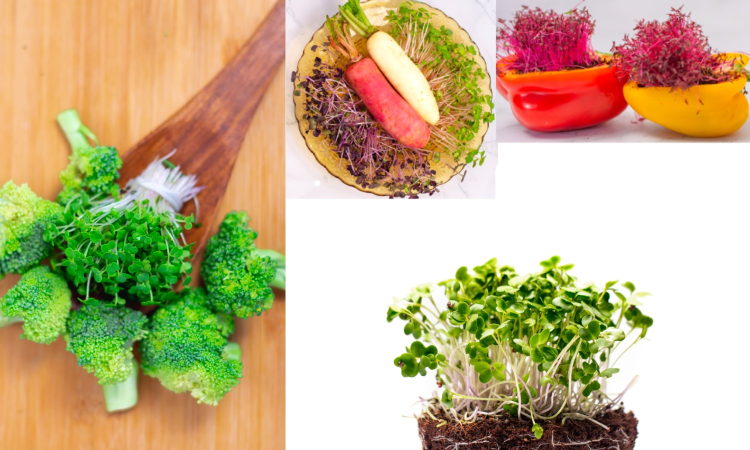From seed to superfood: Exploring the world of microgreens in Chennai
As Chennai is inclining towards health-conscious diet practices, the city is warming up to the idea of microgreens. Why not add these tiny power-packed greens to your diet and let the benefits of microgreens make a big difference in your life?

Microgreens
CHENNAI: Contrary to being a tiny, vibrant plant, microgreens have an intense flavour profile. Unlike its baby size, these small greens are packed with up to 48% more nutrients than their mature counterparts, and fall into the category of superfoods.
Nutrigamy, a Chennai-based startup, is making a mindfully-innovative approach to nutrition through microgreens. Founded in 2021 by Lowarance Kalvin Johnson and Loganathan Selvam, both fresh out of college, the company was born out of a personal quest to combat diabetes and malnutrition.
Microgreens are young vegetable greens harvested just after the first leaves have developed. “They are rich in vitamins, minerals, and antioxidants, making them a powerhouse of nutrition. Each variety has a unique flavour profile—radish microgreens are spicy, sunflower microgreens are nutty and sweet, while others offer an earthy taste,” explains Lowarance.
Despite being small in size, they deliver a burst of flavor and nutrition, making them a versatile addition to salads, omelettes, and even beverages like beer.
However, microgreens are highly perishable and must be consumed raw to retain their nutritional value.
Lowarance Kalvin Johnson and Loganathan Selvam
Chennai market for microgreens
In the early stages, they offered microgreens as garnishes to local hotels, cafes, and bars. “Initially, the response was modest, with many establishments using the greens purely for their aesthetic appeal. However, they have gained attention for their fresh taste and impressive nutritional profile,” says Lowarance. He recalls how people initially viewed microgreens as a novelty.
Originally, Nutrigamy’s target audience was limited to affluent consumers and fitness enthusiasts. “In areas like Adyar, which is home to an affluent and health-conscious demographic, we see increased demand.”
However, the company has since expanded its reach by partnering with dietitians and nutritionists who recommend microgreens to their clients.
What the nutritionist has to say
Microgreen for sure are slowly picking up in Chennai. “When I recently spoke to a friend, she was quick to highlight that she had consumed it in her salad at a restaurant in Chennai,” says Priyanka Ramamurthy, a clinical nutritionist and lifestyle counsellor.
However, Priyanka is uncertain if people understand the true potential of microgreens.
Benefits of microgreens are plenty according to Priyanka. Here are some:
Dense nutrient sources: So they are highly beneficial for people who lack vitamins and minerals, especially somebody like a new mother. Postpartum mothers generally lack micronutrients like iron and calcium and are mostly prescribed supplements for the same. Apart from the supplements, if they can incorporate microgreens in their diet, it helps them achieve the required levels easily and in a more healthier manner.
Small size, big benefits: In their tender stages itself, they have concentrated amounts of micronutrients like vitamin A, C, E, K and also minerals like potassium, calcium and iron.
Rich sources of antioxidants: Now that we are in the trend of people wanting an antioxidant or anti-inflammatory diet, this could be a good fit. Microgreens also offer other benefits like supporting your cardiac health, skin and hair health.
One for gut health: They are just tiny plants but power-packed. So they are rich in fibre that will help in digestion, better bowel movements and overall gut wellness.
Priyanka Ramamurthy
How are microgreens grown?
As a postpartum mother of a four month old, for the 35-year-old Dr Nishitha Reddy, incorporating microgreens has been the best lifestyle change that happened to her. She grows them at home. “If I go to cafes, they sprinkle microgreens as garnish. Later when I started learning about it, I bought them. Little did I know I could plant them in the confines of my home,” she says.
After a dedicated consumption of methi, Dr Nishitha felt a difference. “It is helping me in my feeding process, in a way increasing the supply of milk.”
Is it difficult to grow microgreens? “Not at all. In a pot, I just put methi seeds and tell my elder one to pour water, just sprinkle water so that even he will learn about it.”
With specially formulated soil mixtures, Lowarance and Loganathan grow microgreens in plastic trays with coco peat. After sowing the seeds, they use a precise watering method that includes hydrogen peroxide to ensure proper growth. “Depending on the variety, it takes anywhere from one to two weeks for the microgreens to be ready for harvest,” explains Lowarance. “We use sustainable practices, such as solar energy and air-to-water generators, to minimise costs and contribute to environmental impact.”
Price debate
Despite the growing popularity, microgreens remain a premium product. A 100 gram pack of broccoli microgreens, for instance, costs between ₹50 and ₹300, significantly more than mature broccoli. “We acknowledge this barrier and are working to reduce costs by optimising growing techniques and transitioning to a fully sustainable model,” Lowarance is quick to add.



